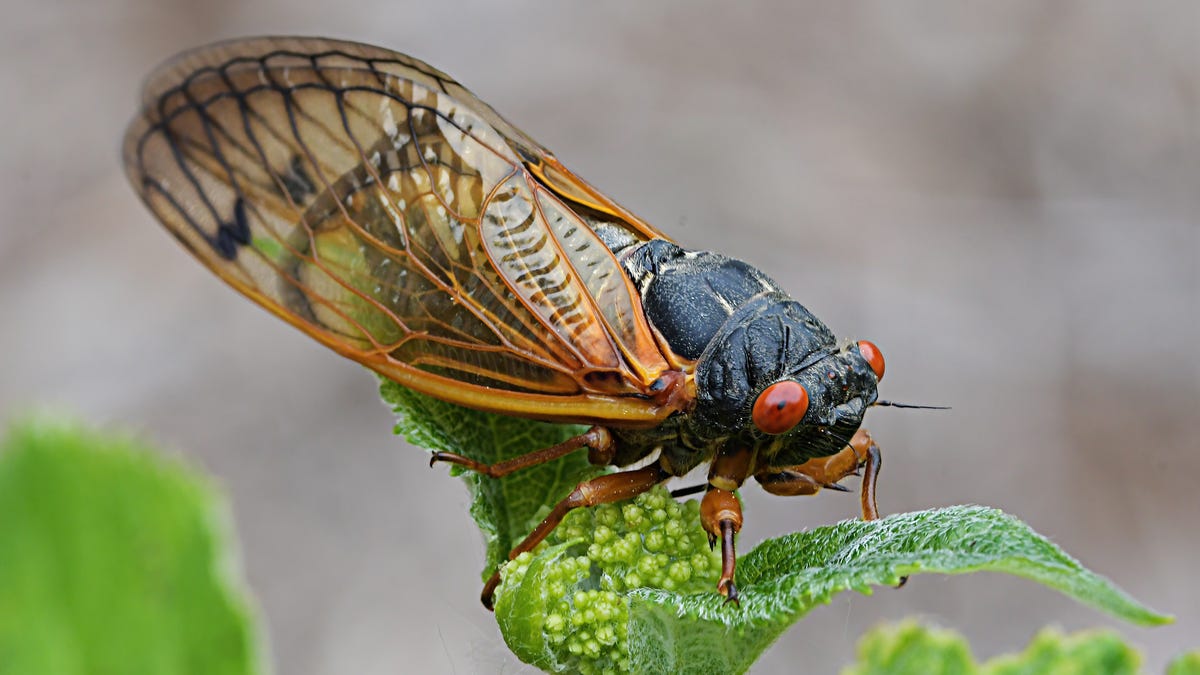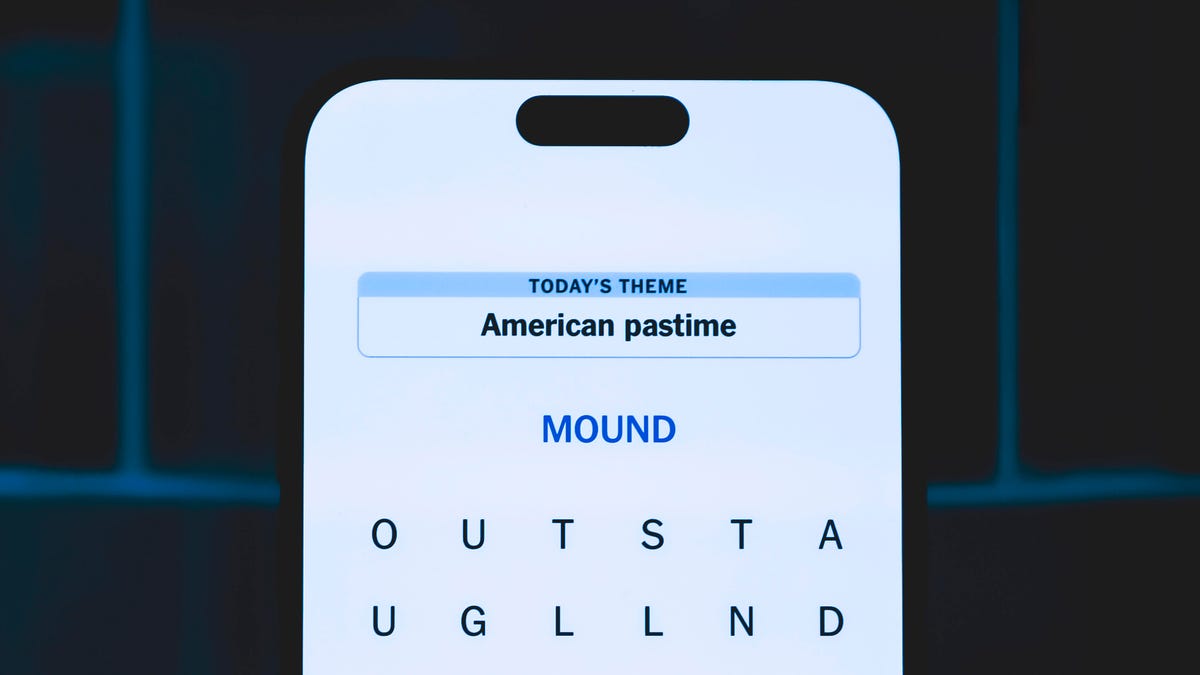Technologies
Cicadas Are Coming, and So Are the Cicada Salad Recipes
Twice the cicada buzz is due in 2024, and some people are already seeing signs of the winged critters. Here come the recipes.

Hungry? Hungry enough to eat a cicada salad? The Audubon Insectarium in New Orleans is prepping for «cicada-geddon» by testing out some buggy recipes. The Associated Press reports that the museum is trying out cicada recipes, including a green salad with apple, almonds and blueberry vinaigrette, with fried cicada nymphs scattered on top.
Recipes or not, the noisy cicadas are about to hit many parts of the US, and some people are already reporting seeing the loud winged insects. Early visitors are already here. One Reddit user in Missouri shared a photo of cicada nymphs beginning to dig their way out from underground from beneath a plastic pool. And in Chicago, residents are organizing a citywide, summer-long art project called Cicada Parade-a, featuring cicada sculptures.
Cicadas have a weird life cycle. They grow underground, but we humans mostly pay attention to them when they emerge into our above-ground world. And this year is a doozy for the buzzy little guys — in an Associated Press story, University of Connecticut cicada expert John Cooley called it «cicada-geddon.»
There are annual cicadas, which emerge from their underground life every year at various times. Then there are periodical cicadas, which emerge only every 13 or 17 years. Those groupings are called broods and are numbered. Because of their trackable schedule, these broods of periodical cicadas tend to steal all the headlines from their annual cicada comrades.
This summer, it’s a double-brood year. That’s rare. According to ScienceAlert, the last time it happened was in 1803. One brood on a 13-year cycle — called Brood XIX — and another on a 17-year cycle — called Brood XIII — are expected to pop out of the ground in 2024.
Here’s what to know before they take over your neighborhood between May and June, including how to protect your hearing from all that cicada noise — and whether climate change could be responsible for be disrupting the cicada cycle.
What’s expected in 2024
Brood XIX
Brood XIX, also called the Great Southern Brood, is the biggest brood of 13-year periodical cicadas, if you go by geographical distribution. It was last seen in 2011 in the Southeast US. Most periodical cicadas are on a 17-year cycle, but Brood XIX is on a 13-year cycle. The two other surviving 13-year broods are expected to return in 2027 and 2028.
This brood is expected to re-emerge in mid-May and stay around through late June. The cicadas tunnel to the surface, mate, lay their eggs and then die off. Look (and listen) for them in Alabama, Arkansas, Georgia, Illinois, Indiana, Kentucky, Louisiana, Mississippi, Missouri, North Carolina, Oklahoma, South Carolina, Tennessee and Virginia.
Brood XIII
Brood XIII is known as the Northern Illinois Brood. Illinois seems to appeal to cicadas more than any other state. Experts at the University of Connecticut say that the Land of Lincoln «contains both 13- and 17-year life cycles, all seven currently recognized species, and five separate broods, some of which include disjunct populations.» Talk about the Big Noise from Illinois.
This is one of the 17-year cicada broods. It was last seen in 2007 and should be back from mid-May to late June, just like Brood XIX. They are expected to appear in Illinois, Indiana, Iowa, Wisconsin and possibly Michigan.
The basics about cicadas
According to the Environmental Protection Agency, cicadas are about 1 to 1.5 inches long, with a wingspan twice that length. They have black bodies, red-brown eyes and membranous wings with orange veins. The noise that makes them famous is the loud courting sound of the adult males.
The name of the species is pronounced differently in the US, where most people say «suh-KEI-duh,» than it is in the UK, where people tend to say, «suh-KAA-dah.»
What to do about the cicadas
Live and let live — they’re temporary and harmless. Cicadas may be noisy, but they don’t bite or sting. And unlike termites, they won’t chew their way into your house, though they could enter through open doors and windows as other insects can. In fact, pest-control experts say that pesticides don’t work on cicadas.
«It’s a waste of (pesticide), and it’s a danger to the environment just to spray down because you’re afraid of the cicadas,» one expert told CNET in 2021.
How can you manage the cicada noise?
The main problem with the cicadas is obvious: their constant buzzing noise. They’re around only for about six weeks, however, so experts have some ideas for how to keep the sound from driving you buggy.
These aren’t cicada-specific remedies, but they work. You might try noise-canceling headphones, white-noise machines or simple earplugs. You can also try some DIY soundproofing, such as weather-stripping foam tape.
Climate change and cicadas
Climate change brings rising global temperatures, and the cicadas aren’t working with a calendar, they’re reacting to temperatures. So it’s unsurprising that scientists believe climate change affects the cicadas as well.
Chris Simon, a professor in the department of ecology and evolutionary biology at the University of Connecticut, has studied and researched cicadas for years.
«Warmer winters and earlier springs will cause cicadas to come out earlier,» Simon told CNET. «Warming climates also increase the growing season in a given area so that cicadas may be ready to emerge from the ground years earlier — generally four years earlier — turning 17-year cicada populations into temporary 13-year cicadas. If this happens repeatedly, we hypothesize that 17-year cicadas could become permanent 13-year cicadas.»
But that change wouldn’t reduce the number of cicadas, Simon told CNET, just adjust their schedule. And it shouldn’t affect the food chain, because «the animals that eat them above ground would see them more often, and the animals that eat them underground would still do so,» Simon said.
While it’s possible that climate change could force the cicadas to move farther north, that won’t be an immediate change. Simon notes that periodical cicadas can move only as adults, and that can happen only for about for weeks every 13 or 17 years. While periodical cicadas can fly, they tend not to move much or migrate long distances. Human-made asphalt and cement obstacles could also prevent the cicadas from taking off to the great white north.
How you can help cicada researchers
Want to help scientists learn more about periodical cicadas?
«Citizen scientists are critical for filling in the parts of the distribution that we do not have time to visit or unknown parts of the distribution that we can later verify,» Simon told CNET.
To help you can download Cicada Safari for iOS or Android, a free app developed by Simon’s colleague Gene Kritsky. The app asks people to take a cicada photo using their phone, with geolocation allowed.
«(Kritsky’s) team will verify photos and log the data and share it with us,» Simon said.
How to protect new, small trees from cicadas
While cicadas shouldn’t hurt large, mature trees, new young trees may be vulnerable. Female cicadas like to lay their eggs on trees where new leaves are located, puncturing the branches and possibly causing leaves to wither, turn brown and even snap. So if you live in a cicada territory, hold off on planting any new trees until they’re gone, which should be in late June.
If you have new small trees and are worried about cicada damage, you may want to loosely wrap their trunks and the areas where twigs meet the branches. You can use cheesecloth, foil tape, barrier tape or sticky tape. You could also use landscaping nets around smaller trees. CNET has a guide to tree protection against cicadas.
People eat cicadas?
The New Orleans museum isn’t alone. You can actually eat cicadas. Don’t even try it, though, if you have seafood allergies, because cicadas are related to shrimp and lobster.
If you’re made of tough stuff and don’t get easily queased-out by unusual foods, there are plenty of simple cicada recipes on the web. An expert from Johns Hopkins University says they’re «quite tasty» but admits «the yuck factor» might keep most of us from even trying.
The good news, though, is that if your dog wolfs a few down — and dog owners know some pups will eat literally anything — cicadas shouldn’t harm them. Just watch that they don’t choke from eating too many at once.
Technologies
Today’s NYT Connections Hints, Answers and Help for Dec. 26, #929
Here are some hints and the answers for the NYT Connections puzzle for Dec. 26 #929

Looking for the most recent Connections answers? Click here for today’s Connections hints, as well as our daily answers and hints for The New York Times Mini Crossword, Wordle, Connections: Sports Edition and Strands puzzles.
Today’s NYT Connections puzzle is full of fun pop-culture references. Read on for clues and today’s Connections answers.
The Times has a Connections Bot, like the one for Wordle. Go there after you play to receive a numeric score and to have the program analyze your answers. Players who are registered with the Times Games section can now nerd out by following their progress, including the number of puzzles completed, win rate, number of times they nabbed a perfect score and their win streak.
Read more: Hints, Tips and Strategies to Help You Win at NYT Connections Every Time
Hints for today’s Connections groups
Here are four hints for the groupings in today’s Connections puzzle, ranked from the easiest yellow group to the tough (and sometimes bizarre) purple group.
Yellow group hint: Golden state cliches.
Green group hint: Funny films.
Blue group hint: Rock on.
Purple group hint: Not white.
Answers for today’s Connections groups
Yellow group: California-based character tropes.
Green group: Comedy subgenres.
Blue group: ’70s rock bands.
Purple group: Black ____.
Read more: Wordle Cheat Sheet: Here Are the Most Popular Letters Used in English Words
What are today’s Connections answers?
The yellow words in today’s Connections
The theme is California-based character tropes. The four answers are movie exec, surfer, tech bro and Valley Girl.
The green words in today’s Connections
The theme is comedy subgenres. The four answers are buddy, cringe, screwball and stoner.
The blue words in today’s Connections
The theme is ’70s rock bands. The four answers are America, Chicago, Foreigner and Journey.
The purple words in today’s Connections
The theme is black ____. The four answers are Forest, Friday, Panther and Widow.
Don’t miss any of our unbiased tech content and lab-based reviews. Add CNET as a preferred Google source.
Technologies
Today’s NYT Strands Hints, Answers and Help for Dec. 26 #663
Here are hints and answers for the NYT Strands puzzle for Dec. 26, No. 663.

Looking for the most recent Strands answer? Click here for our daily Strands hints, as well as our daily answers and hints for The New York Times Mini Crossword, Wordle, Connections and Connections: Sports Edition puzzles.
Today’s NYT Strands puzzle is a fun one, but you might struggle at first to see a connection between the words. If you need hints and answers, read on.
I go into depth about the rules for Strands in this story.
If you’re looking for today’s Wordle, Connections and Mini Crossword answers, you can visit CNET’s NYT puzzle hints page.
Read more: NYT Connections Turns 1: These Are the 5 Toughest Puzzles So Far
Hint for today’s Strands puzzle
Today’s Strands theme is: Please hold.
If that doesn’t help you, here’s a clue: Cats love these more than they love expensive toys.
Clue words to unlock in-game hints
Your goal is to find hidden words that fit the puzzle’s theme. If you’re stuck, find any words you can. Every time you find three words of four letters or more, Strands will reveal one of the theme words. These are the words I used to get those hints, but any words of four or more letters that you find will work:
- BOXING, CHEAT, HEAT, SMOCK, MOCK, LATE, TEAM, MEAT, TEAMS, LOOT, TOLE, BALL, BALE, KALE, TALL
Answers for today’s Strands puzzle
These are the answers that tie into the theme. The goal of the puzzle is to find them all, including the spangram, a theme word that reaches from one side of the puzzle to the other. When you have all of them (I originally thought there were always eight but learned that the number can vary), every letter on the board will be used. Here are the nonspangram answers:
- GIFT, SHOE, TOOL, LUNCH, MATCH, PIZZA, BALLOT, TACKLE (All are words that can be placed in front of «box.»)
Today’s Strands spangram
Today’s Strands spangram is BOXINGDAY. To find it, start with the B that’s four letters down on the far-left row, and wind across and then down.
Don’t miss any of our unbiased tech content and lab-based reviews. Add CNET as a preferred Google source.
Technologies
Today’s Wordle Hints, Answer and Help for Dec. 25, #1650
Here are hints and the answer for today’s Wordle for Dec. 25, No. 1,650.

Looking for the most recent Wordle answer? Click here for today’s Wordle hints, as well as our daily answers and hints for The New York Times Mini Crossword, Connections, Connections: Sports Edition and Strands puzzles.
Today’s Wordle puzzle has some tough-to-guess letters. If you need a new starter word, check out our list of which letters show up the most in English words. If you need hints and the answer, read on.
Read more: New Study Reveals Wordle’s Top 10 Toughest Words of 2025
Today’s Wordle hints
Before we show you today’s Wordle answer, we’ll give you some hints. If you don’t want a spoiler, look away now.
Wordle hint No. 1: Repeats
Today’s Wordle answer has no repeated letters.
Wordle hint No. 2: Vowels
Today’s Wordle answer has one vowel.
Wordle hint No. 3: First letter
Today’s Wordle answer begins with P.
Wordle hint No. 4: Last letter
Today’s Wordle answer ends with M.
Wordle hint No. 5: Meaning
Today’s Wordle answer can refer to a geometric figure.
TODAY’S WORDLE ANSWER
Today’s Wordle answer is PRISM.
Yesterday’s Wordle answer
Yesterday’s Wordle answer, Dec. 24, No. 1649, was SPOOL.
Recent Wordle answers
Dec. 20, No. 1645: WHITE
Dec. 21, No. 1646: QUILT
Dec. 22, No. 1647: CONCH
Dec. 23, No. 1648: GLINT
Don’t miss any of our unbiased tech content and lab-based reviews. Add CNET as a preferred Google source.
What’s the best Wordle starting word?
Don’t be afraid to use our tip sheet ranking all the letters in the alphabet by frequency of uses. In short, you want starter words that lean heavy on E, A and R, and don’t contain Z, J and Q.
Some solid starter words to try:
ADIEU
TRAIN
CLOSE
STARE
NOISE
-

 Technologies3 года ago
Technologies3 года agoTech Companies Need to Be Held Accountable for Security, Experts Say
-

 Technologies3 года ago
Technologies3 года agoBest Handheld Game Console in 2023
-

 Technologies3 года ago
Technologies3 года agoTighten Up Your VR Game With the Best Head Straps for Quest 2
-

 Technologies4 года ago
Technologies4 года agoBlack Friday 2021: The best deals on TVs, headphones, kitchenware, and more
-

 Technologies4 года ago
Technologies4 года agoVerum, Wickr and Threema: next generation secured messengers
-

 Technologies4 года ago
Technologies4 года agoGoogle to require vaccinations as Silicon Valley rethinks return-to-office policies
-

 Technologies4 года ago
Technologies4 года agoOlivia Harlan Dekker for Verum Messenger
-

 Technologies4 года ago
Technologies4 года agoiPhone 13 event: How to watch Apple’s big announcement tomorrow
